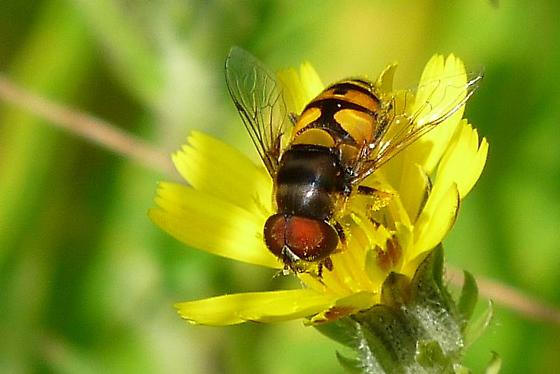Classification
Kingdom:
Animalia
Phylum: Arthropoda (subphylum Hexapoda)
Class: Insecta
Order: Diptera
Family Syrphidae
Genus Eristalis
Species:
Eristalis transversa
Domain: Eukarya
This species is in the domain Eukarya because it is a
multicellular organism with eukaryotic cells containing
organelles such as the mitochondria. (Hickman et all 2009)
Kingdom: Animalia
This species is a member of the kingdom animalia because
it relies on other organisms for its nourishment (heterotroph)
as well as having an embryonic stage of development and
bilateral symmetry. (Hickman et all 2009)
Phylum: Arthropoda
This species gains access to the phylum arthropoda by
virtue of several characteristics including: a segmented body
plan, tracheal tubes for respiration (terrestrial arthropods
share this characteristic) a versatile exoskeleton that grows
via ecdysis, highly developed sensory organs, as well as paired
segmented appendages. (Hickman et all 2009)
Class: Insecta (Subphylum Hexapoda)
The class Insecta, along with one other very small class,
is found in the subphylum Hexapoda. Members of the class insecta
are distinguishable from other arthropods for a variety of
reasons, the principle of which is their body plan. Class
insecta has 3 tagmata: the head, thorax, and abdomen.
Additionally, this class is characterized by three pairs of legs
(6 legs total) and two pairs of wings. (Hickman et all 2009)
Some subgroups have modifications but this general body plan
holds true for most of the class.
Order: Diptera
This fly is in the order diptera because it has only one
pair of wings; the second pair of wings has been modified into
small structures called halters that function as gyroscopes
during flight to keep the organism oriented.(Kaufman 2007) These
halters are responsible for the hovering capabilities of these
flies, giving rise to the nickname of hover flies. Additionally,
adults are winged while larvae (young) are not.
Family Syrphidae
The family Syrphidae has several unique features that set
it apart from other families of flies. The first of these is
that nearly all members of this family are predators of aphids,
one of their main food sources.(Berry 1998) They also tend to
feed on pollen and nectar which is related to an unique
adaptation which is their camouflage.
All members of this
family have coloration and body plans that resemble wasps and
bees, more specifically alternating yellow, black, or white
bands. (Berry 1998) This coloration scheme, combined with their
characteristic hovering behavior, affords this family a degree
of protection- most organisms will not bother anything that
resembles a bee or wasp for fear of being stung.
Genus Eristalis
The genus eristalis has an interesting
larval stage that is mostly predacious, feeding on primarily
aphids. They are important in regulating aphid populations. (Skevington 2011) Adults of this
genus can be found on flowers or near areas with a large amount
of flowering plants as they are honey bee mimics, following
coloration patterns of both honey bees and wasps. While the
adults do not eat aphids themselves, they suck the honeydew from
aphids for part of their nutrition.
Species: Eristalis
transversa
The Hover fly/Flower fly! So named for its
flight pattern of hovering above flowers, much like a
hummingbird. In fact, hover flies primary food source, besides
aphids, is honey and nectar from flowers. As such they are key
pollinators for many habitats. (Kaufman 2007) The individual
species of the Eristalis
genus only differ slightly, especially in morphology/appearance.
The main differences lie in the coloration of the dorsal side of
the body. Eristalis
transversa is distinguishable by its bright opaque yellow
scutellum and its half-grey, half-black thorax. The presence of
the yellow scutellum is often used for identification as it is
truly unique to Eristalis
transversa. (Skevington 2011)
